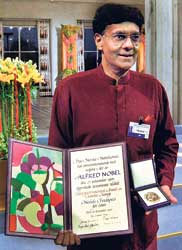
Climate change: The global warning!“Devo Vassatu kalena “May the rains come in time, “As this ancient Pali blessing portrays, a favourable environment, economic prosperity, social stability and good governance are the key factors for making development more sustainable. It is rightly the challenges we face in the present day fight against climate change,” Prof. Mohan Munasinghe said at a felicitation ceremony held last week. The Inter Governmental Panel on Climate Change (IPCC) – the UN’s scientific lobby in the fight against Climate Change, shared the Nobel Peace Prize recently with former US Vice President Al Gore for building up and disseminating greater knowledge about man-made climate change, and how to counteract it. Prof. Munasinghe, Vice-Chairman of the IPCC was felicitated at a ceremony held at the Government Information Department auditorium last week.
The United Nations adopted the Kyoto Protocol to reduce greenhouse gas emissions as mitigation, but this was not supported by some of the industrialized nations. This month, world nations again gathered in Bali, Indonesia to discuss the road map after the expiration of Kyoto Protocol in 2012 to continue mitigation. The Bali road map is a good starting point for the second round in the fight against climate change. “An agreement has been made to establish the Adaptation Fund to finance concrete adaptation projects in developing countries. This fund will assist developing nations like Sri Lanka to adapt to the adverse effects of climate change, such as drought, floods and crop failure,” Prof. Munasinghe explained. “Delegates in Bali also agreed on a framework that could allow richer nations and companies to earn “Carbon Credits” by paying for forest protection in developing countries and thereby contributing to mitigate global warming. This is widely acknowledged as the cheapest single way of curbing climate change, and brings benefits in other environmental areas such as biodiversity and fresh water conservation,” he said. It is predicted that Sri Lanka’s Dry Zone will be badly hit by climate change. The slight increase of temperature will result in severe droughts and the scarcity of water, already a problem, will badly affect paddy farming. Unfortunately, as the small scale paddy farmer is already poverty-stricken, it stands to become a socio-economic problem. On the other hand, the wet zone might experience more rains, resulting in floods and landslides. This change might however have a positive impact for crops like tea.“Sri Lanka will have to face more extreme weather events as a result. Our data already shows there is a change in the distribution of rainfall. The annual rainfall doesn’t show a major difference, but areas are starting to get heavy rainfall in the course of shorter periods. This results in extreme weather patterns and we fear it may worsen,” commented Director General of the Meteorology Department, G.H.P. Dharmaratna. A separate unit – the Centre for Climate Change Studies- has been set up to analyze any adverse climatic changes happening in Sri Lanka under the Department of Meteorology. “The unit is keeping a close eye on shifting patterns,” the DG said. The Global Affairs and Environmental Economics Unit of Ministry of Environment will also start compiling their report on climate change effects in Sri Lanka from next January. This has been an obligation by all the countries in coalition and Anura Jayathilake, Director of Global Affairs and Environmental Economics believes the three-year study will capture negative as well as positive effects. Going forward, Sri Lanka will have to develop a strategy at international level by engaging actively and constructively in international negotiations and make greater efforts to seek funds and technical assistance for adaptations and vulnerability reduction. It is also necessary to explore and learn about Clean Development Mechanism and carbon trading prospects. According to the Kyoto Protocol, developed countries should commit themselves to cut their greenhouse gas emissions to the agreed levels. Developing countries that have no legal commitments under the protocol can assist developed countries to reduce GHG missions and charge a price for their emission reduction. This is called the Clean Development Mechanism (CDM) or the International Carbon Market. In order for Sri Lanka to capture a considerable share of the international Carbon Market, the country should act fast and adopt a proactive strategy. The Finance Ministry has proposed establishing the new Carbon Fund for Sri Lanka, which has been approved by the recent Budget. Sri Lanka is still in the initial stage of CDM project implementation compared to neighbouring India and many other developing countries. Five CDM projects from Sri Lanka have already been registered out of a total of 315 projects worldwide. Sri Lankan projects have already marketed 134,000 tons of CO2. A few more projects are in the pipeline mainly from the power generation sector but attempts by the private sector to initiate CDM projects have failed due to various constraints. One of the weaknesses in the campaign maybe the inability of scientists to translate their jargon into language that is understood by everyone, including politicians. However, this gap is being bridged. “Civil Society can play a vital role in forcing the policymakers to take environmentally favourable decisions,” Prof. Munasinghe said. |
|| Front
Page | News | Editorial | Columns | Sports | Plus | Financial
Times | International | Mirror | TV
Times | Funday
Times || |
| |
Reproduction of articles permitted when used without any alterations to contents and the source. |
© Copyright
2007 | Wijeya
Newspapers Ltd.Colombo. Sri Lanka. All Rights Reserved. |
